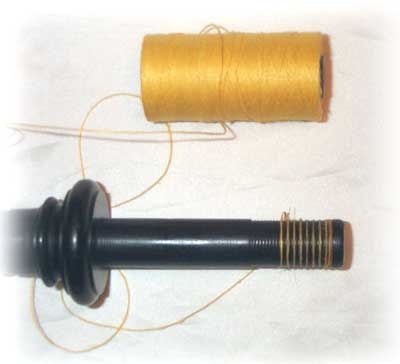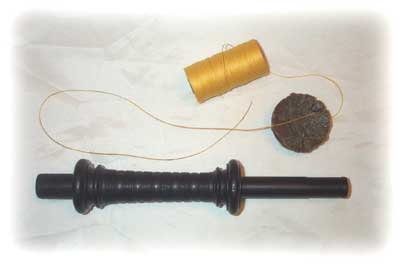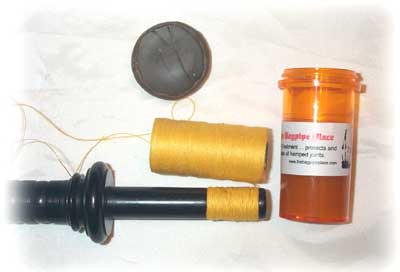One of the biggest frustrations that I encounter is improperly hemped tenons. The tenon is the part that fits into a tuning chamber or into a stock. It's the part that is wrapped with hemp to ensure an airtight seal. When a tenon is properly hemped it fits evenly and securely into the receiving part, not too tight and not too loose. As simple as this sounds, it is rare to find a piper who will take the time to do this correctly.
First of all it should be understood that there is no such thing as a "maintenance-free" bagpipe. Bagpipes require ongoing care and attention and this should be expected and accepted. Too often we look for the easy way out, only to learn the hard way that the "easy way out" was the tried 'n true way. Maybe it takes a bit longer and a bit of ongoing care and attention, however it will save you time, money, and frustration over the long haul.
Let's look at what we want from hemp. We want a fit that's tight enough to keep the repective pieces where we put them. We want a fit that's guaranteed air-tight. We want a fit that will move when we want it to move. We want a fit that is not harmful to our pipes. Like it or not, we just haven't found anything that works better than unwaxed yellow hemp
Everytime I see a gob of waxed hemp that's been compressed into a molten mess I want to scream. I am hardpressed to think of anything that is potentially more harmful to your pipes. Think about it! This gob has no cushion or "give" whatsoever. Rather than ranting about the wrong way to hemp joints, let's focus on the right way
First of all it should be understood that there is no such thing as a "maintenance-free" bagpipe. Bagpipes require ongoing care and attention and this should be expected and accepted. Too often we look for the easy way out, only to learn the hard way that the "easy way out" was the tried 'n true way. Maybe it takes a bit longer and a bit of ongoing care and attention, however it will save you time, money, and frustration over the long haul.
Let's look at what we want from hemp. We want a fit that's tight enough to keep the repective pieces where we put them. We want a fit that's guaranteed air-tight. We want a fit that will move when we want it to move. We want a fit that is not harmful to our pipes. Like it or not, we just haven't found anything that works better than unwaxed yellow hemp
Everytime I see a gob of waxed hemp that's been compressed into a molten mess I want to scream. I am hardpressed to think of anything that is potentially more harmful to your pipes. Think about it! This gob has no cushion or "give" whatsoever. Rather than ranting about the wrong way to hemp joints, let's focus on the right way
Start by treating the first 12 inches or so of yellow unwaxed hemp with cobbler's wax. Don't use wax or some cheap substitute for the good stuff. Check out the cobblers wax in the store. It's excellent. This will anchor the hemp to the tenon and prevent it from spinning. This is critical if you're going to prevent nasty problems from cropping up later.
Run the hemp through the cobbler's wax several times to coat it thoroughly. Wrap the coated hemp onto the tenon. It's really not necessary to wrap it more than 6 or 8 times around the tenon in order to anchor the hemp. Now build the cushion by criss-crossing the hemp back and forth, angling one way going down the tenon and the opposite way going back up the tenon. In this way you create a honey-comb effect with tiny pockets that help to create a cushion. Pay attention to wrap the hemp so that it is even across the tenon and not higher in the middle. This will cause the mated section to wobble, compromising the sound and behavior of your drone. Finish it oww by wrapping the final layers evenly across the hemp bed, testing the "fit" by inserting the tenon into the receiving piece. The fit should be snug but not tight. When the fit is just right, tie it off with a half-hitch.
Finish off the tenon by applying a non-mineral based lubricant liberally across the top layer of hemp. (I used to sell "Ringo's Hemp Treatment" however other projects have taken me away from this. I'll probably start this up again, so watch for it.) Make sure it is make of non-mineral ingredients as they can have a harmful effect on the wood. This will help to ward off moisture and lubricate the joint. To be sure, this procedure will require some upkeep, however the end result is far more favourable than the alternatives. You can apply more lubricant any time you feel the need. If you need to apply more hemp, just apply is atop the existing bed of hemp.
Hemp - The Right Way!




